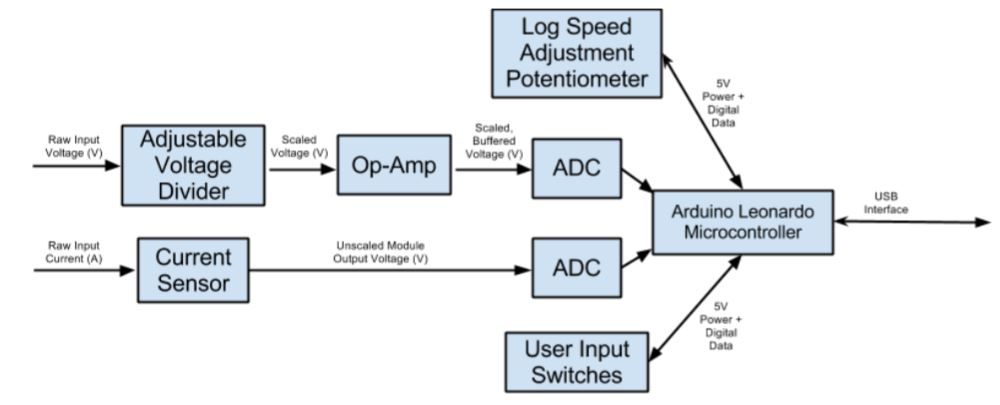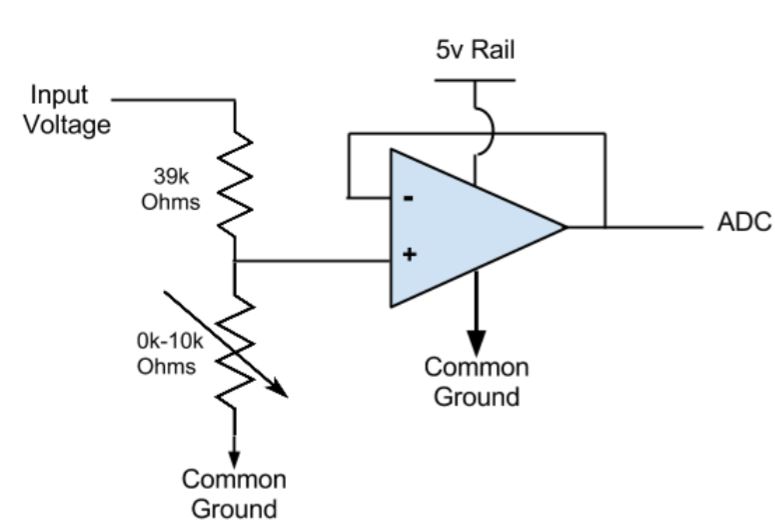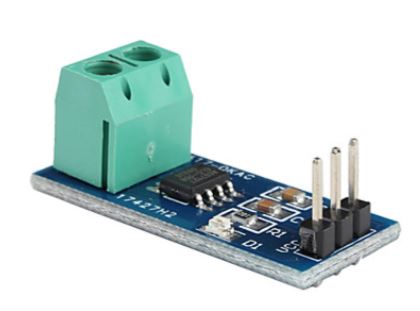ABSTRACT
The purpose of this project is to design and build a low cost, portable USB data logger for electrical engineering labs. This data logger connects to any computer through a USB port and appears as a keyboard to the host’s operating system. The logger performs electrical measurements and records the data by emulating keyboard strokes inside any spreadsheet program or analysis tool without the need for software or ancillary hardware. The logger is capable of measuring voltage and current. The end result of this project is to create a low cost, easy to use solution for data collection that can be replicated by other students.
BACKGROUND

Figure 1: Block Diagram of System Components
This prevents students and hobbyists from purchasing devices that might be of use to them. By keeping the price of this device low and affordable, the target market will be broader to increase the amount of consumers while providing students and hobbyists with devices that are made for students, for students, and created by students. The diagram below in figure 1 shows the major components of the project.
DESIGN

Figure 2: Input voltage stage circuit diagram
The voltage range was decided to be 0-25V. This was done with a 39K ohm/10K ohm resistive divider(seen in figure 2.) Three voltage input stages were chosen for a specific reason. Generally, in electrical engineering labs, the input voltage and the output voltages are measured. The third input stage is to allow the user to measure a voltage difference, while measuring a voltage with an uncommon ground.

Figure 3: ACS712 LC Electronics 05Amp AC/DC Hall Effect Current Sensor Module
The current sensor (Figure 3) was chosen based on price and functionality. It can only handle 05A, but this was determined to be sufficient for general circuit use. This device was chosen not because it was a highpowered, highfunctioning sensor, but because it was the most costeffective sensor that gave an acceptable current range. The current device (shown below) is connected to the common ground and the 5V output of the Arduino Leonardo. The output signal from the module is connected directly to one of the ADC ports.
DEVELOPMENT AND CONSTRUCTION

Figure 7 : Fall Quarter Gantt Chart
From there, we created and tested the most basic subassembles of the system: the voltage divider, current sensor and the ADC input into the microcontroller. By the end of Winter Quarter, the device was tested for basic functionality which included reading voltage and current values. The device should also be tested for datalogging and communication to the computer through USB in order to operate with the datalogging software.
CONCLUSION
This device meets the requirements and goals set at the start of the project. The first requirements were ease of use and portability. The device is small enough to transport from place to place, lightweight, and is stable enough not to break or fall apart. The device also requires no special software uploaded by the user. Once the code is written onto the microprocessor, it will function on any computer. The data logger also utilizes just one common micro USB to USB maletomale cable to connect to a computer and once connected, it is able to log data at the flip of a switch.
The device itself is easy to understand. It has clear terminals for voltage and current inputs as well as an easy to see switch system to control when the device records and doesn’t record. Another criteria was price (see appendix B.) The total price of the hardware and software needed to build this product was $34.37, this is a slightly higher price than the initial estimate. We first envisioned a price of around $20. This became a enlarged when we changed the design to include an Arduino Leonardo. This microprocessor is a significant upgrade from the PIC originally chosen in terms of easy usability.
The Leonardo offered more features to help with the keyboard emulation, and therefore the increase in price was deemed acceptable. A final price of $34.37 still meets our requirements. The market for this type of device is substantially above our component price. When considering the customer for this device, a college student with limited funds, it was important to make this an affordable alternative. This price was met and this was done while still meeting acceptable accuracy numbers.
Source: California Polytechnic State University
Authors: San Luis Obispo